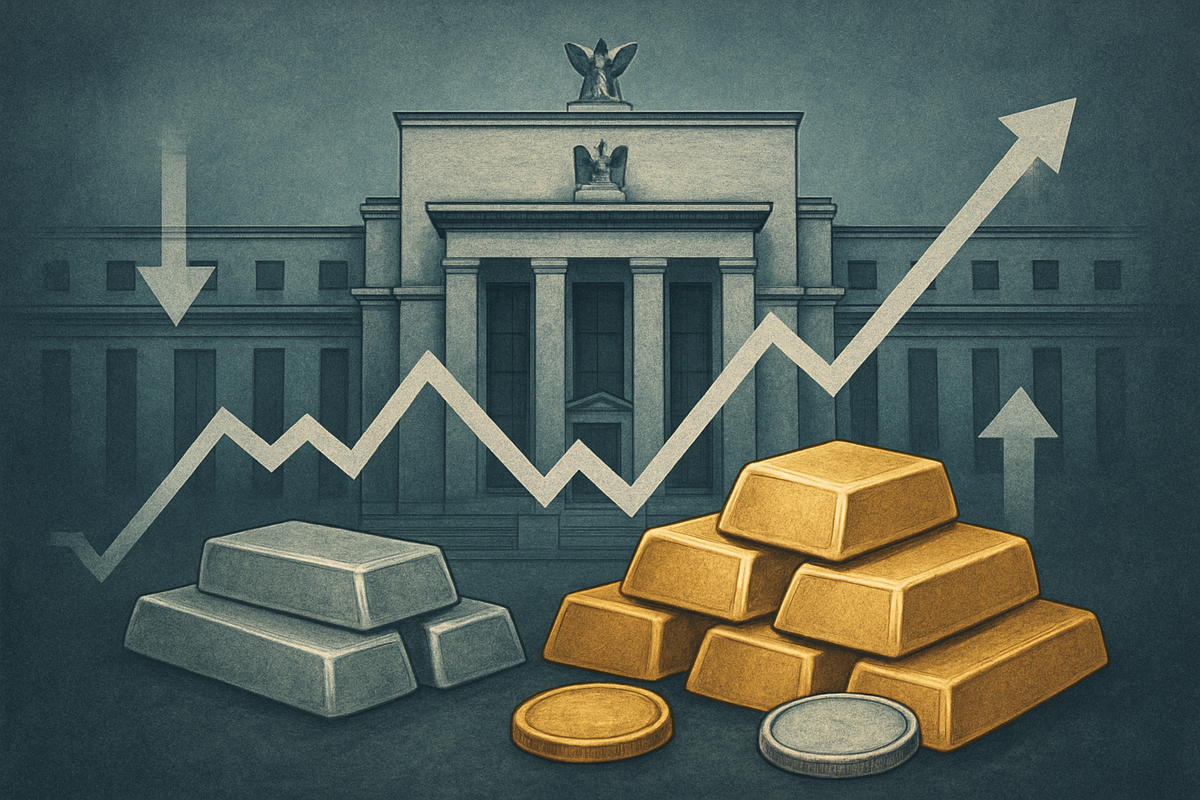
As October 2025 draws to a close, the financial markets are abuzz with a significant shift in the Federal Reserve's monetary policy. While not a direct re-launch of Quantitative Easing (QE), the Fed's decision to conclude its quantitative tightening (QT) program by December 1, 2025, coupled with recent interest rate cuts, has ignited widespread speculation about the potential for future QE. This dovish pivot is sending ripples through asset classes, with particular attention focused on the traditional safe havens of gold and silver.
This strategic adjustment by the Fed, moving away from shrinking its balance sheet and towards supporting economic growth amidst persistent inflation, has immediate implications. Investors are keenly watching how this influx of liquidity (or cessation of withdrawal) will influence the purchasing power of the dollar and, consequently, the attractiveness of precious metals as a hedge against currency debasement and economic uncertainty. The stage is set for a volatile period where the interplay between monetary policy, inflation, and market sentiment will dictate the trajectory of gold and silver prices.
The Fed's New Stance: Ending QT and Cutting Rates
The Federal Reserve's recent actions mark a crucial turning point in its post-pandemic monetary policy. After years of aggressive quantitative tightening aimed at shrinking its massive balance sheet, the Federal Open Market Committee (FOMC) announced in October 2025 that it would cease the runoff of its asset portfolio by December 1, 2025. This decision effectively ends the multi-year effort to reduce the Fed's balance sheet, which had declined from its peak of approximately $9 trillion in mid-2022 to about $6.6 trillion by October 2025. While this is not a new QE program, it signals a halt to the withdrawal of liquidity from the financial system, with plans to reinvest maturing mortgage-backed securities (MBS) into Treasury bills to normalize the portfolio's composition.
This balance sheet stabilization comes hand-in-hand with a more accommodating interest rate policy. In both September and October of 2025, the FOMC implemented 25-basis-point reductions to the federal funds rate, bringing the target range to 3.75%-4.00%. These rate cuts were explicitly framed as "risk management" steps, aimed at countering a perceived slowdown in hiring and wage growth, and protecting a labor market that has shown signs of softening. Key players, including Fed Chair Jerome Powell, have emphasized a data-dependent approach, noting that while disinflation continues in services, goods inflation has picked up, with the Consumer Price Index (CPI) still at 3% year-over-year in September, above the Fed's 2% target. The initial market reaction to these moves has been a mix of relief over potential economic support and renewed concerns about inflation, pushing some investors back towards inflation hedges like precious metals.
Potential Winners and Losers in a Shifting Landscape
The Federal Reserve's pivot, characterized by ending quantitative tightening and implementing rate cuts, has significant implications for various sectors and companies, particularly those tied to precious metals. The immediate beneficiaries are likely to be gold and silver mining companies. A more accommodative monetary policy, even if not outright QE, tends to weaken the U.S. dollar and reduce real interest rates, making non-yielding assets like gold and silver more attractive. Companies such as Barrick Gold (NYSE: GOLD), Newmont (NYSE: NEM), and Wheaton Precious Metals (NYSE: WPM) could see increased investor interest, potentially boosting their stock prices as the underlying commodity prices rise. Lower interest rates also reduce borrowing costs for these capital-intensive operations, improving their profit margins.
Conversely, a sustained period of higher inflation, even with slower growth, could erode the purchasing power of fixed-income investments, making them less appealing. While financial institutions might initially benefit from increased market liquidity, a prolonged period of low rates and potential inflation could squeeze net interest margins in the long run. Sectors reliant on a strong dollar or those sensitive to inflation, such as certain consumer discretionary companies, might face headwinds. However, for investors seeking refuge from economic uncertainty and currency devaluation, the precious metals sector stands out as a clear potential winner, especially if the current dovish stance evolves into actual quantitative easing should economic conditions deteriorate further.
Wider Significance: A Return to the "New Normal"?
The Federal Reserve's latest policy adjustments—halting quantitative tightening and initiating rate cuts—represent a significant inflection point, signaling a potential return to a more interventionist approach that defined much of the post-2008 era. This move fits into a broader trend of central banks globally grappling with persistent inflation pressures alongside concerns about economic growth and labor market stability. The Fed's pivot suggests that the era of aggressive balance sheet reduction might be over for now, indicating a prioritization of financial stability and employment support over solely combating inflation through balance sheet contraction.
The potential ripple effects are far-reaching. Competitors and partners in the global financial system will closely watch the dollar's strength, which tends to weaken under dovish Fed policies, affecting trade balances and commodity prices. Regulatory bodies will also be under pressure to monitor potential asset bubbles that could form if liquidity remains abundant. Historically, periods of quantitative easing or highly accommodative monetary policy have been strongly correlated with rising gold and silver prices. During the various rounds of QE following the 2008 financial crisis, precious metals often served as a hedge against inflation and currency debasement, seeing substantial gains. This historical precedent provides a strong indicator for how markets might react if the Fed's current dovish stance were to escalate into full-blown QE, reinforcing the belief that gold and silver could once again act as critical safe havens.
What Comes Next: Navigating the Uncertainty
The path forward for the Federal Reserve and, by extension, the financial markets, remains fraught with possibilities. In the short term, the market will be keenly watching for further economic data, particularly inflation reports and labor market indicators. Should inflation prove stickier than anticipated, or if economic growth falters more severely, the pressure on the Fed to either maintain its current stance or even consider more aggressive measures, including a potential return to full-fledged Quantitative Easing, will intensify. This scenario would likely bolster gold and silver prices significantly, as investors seek protection against monetary expansion and currency debasement.
Long-term possibilities include a prolonged period of elevated inflation combined with moderate growth, often termed "stagflation," which historically has been very favorable for precious metals. Alternatively, if the Fed's rate cuts successfully stimulate the economy without reigniting runaway inflation, the need for QE might recede, potentially dampening the upside for gold and silver. Market opportunities may emerge for investors who strategically position themselves in commodity-linked assets and inflation-protected securities. However, challenges include navigating increased market volatility and the risk of policy missteps. Potential scenarios range from a soft landing for the economy with controlled inflation, to a more challenging environment necessitating further dovish interventions. Investors should prepare for adaptive strategies, closely monitoring Fed communications and economic data for clues on the next policy moves.
Wrap-Up: Gold and Silver in the Spotlight
The Federal Reserve's recent pivot—ending quantitative tightening and initiating rate cuts in late 2025—marks a pivotal moment for financial markets, placing gold and silver firmly in the spotlight. Key takeaways include the Fed's renewed focus on supporting economic growth and labor markets, even as inflation remains a concern. While not an explicit return to QE, the cessation of balance sheet reduction and the dovish interest rate policy create an environment ripe for speculation about future monetary expansion, making precious metals increasingly attractive as hedges against potential inflation and currency weakness.
Moving forward, the market will be a delicate balance of inflation expectations, economic growth prospects, and the Fed's evolving policy stance. Gold and silver are poised to benefit from this uncertainty, particularly if the U.S. dollar weakens and real interest rates decline further. Investors should watch for continued signs of economic slowdown, any uptick in inflation, and especially any explicit signals from the Federal Reserve regarding the possibility of new asset purchase programs. These factors will be critical in determining the sustained appeal and price trajectory of precious metals in the coming months, as the financial world navigates what could be a new era of accommodative monetary policy.
This content is intended for informational purposes only and is not financial advice






